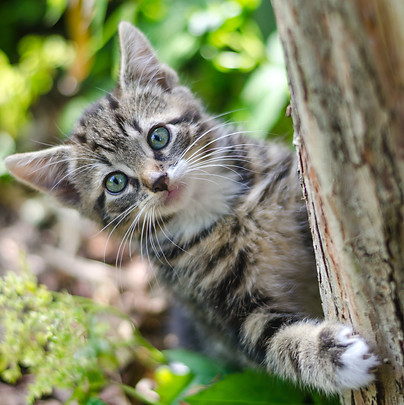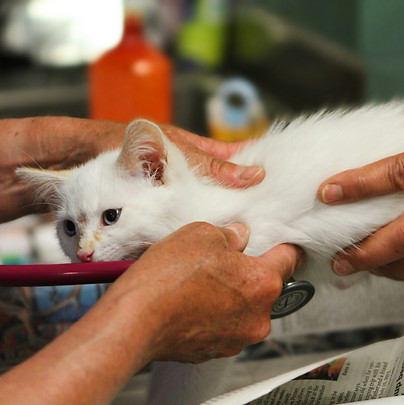
Resources
What to Do if You Find Kittens
If you find a litter of kittens near your house or in a park, it's important to observe their situation and ask a few questions before you act:
-
Is a mother cat nearby? No one can care for young kittens like their moms. Kittens who are only a few months old are reliant on milk and can't eat solid food yet. The mother cat may be hiding from you, so
-
How old are the kittens? If the kittens are between 4 and 8 weeks old, they are at the right age to be adopted. See if they are friendly to humans. If they are, foster or adopt them yourself! If you're unable to provide a home, reach out to your local Animal Shelter for advice. Living with a loving human family is the safest and best option for most kittens who are not afraid of people.
-
What resources are available? If possible, contact a local Trap, Neuter, Release (TNR) program or Animal Shelter. Medical care is especially important if the kittens or the mother seem unhealthy. If these types of resources aren't available, do what you can to provide food and shelter for the feline family.
Bringing a New Cat Home
Introducing a new family member can be stressful for everyone. Cats thrive on sameness and take time to adapt to new environments.
-
Start your new cat off in a small, quiet room (like a spare bathroom) with everything they need: food, water, a litterbox, toys, soft bedding, and a cardboard box or other hidey hole.
-
Bring a blanket or other familiar smells from the cat's old home and introduce new smells slowly. Feliway, a spray or diffuser that releases feline pheromones, may help calm some cats.
-
Get your new cat used to a regular feeding and play schedule.
-
Introduce new people and other pets slowly. Don't force interactions if your new cat hisses or hides. Adapting to a new environment may take several weeks.

Cat Care 101
Cats need a lot of the same things that people do: food, water, entertainment, medical care, exercise, sleep, and somewhere to go to the bathroom.
-
Food. Cats may be able to survive on human food, but they are carnivores who require a special diet to thrive. Talk to your vet about your cat's unique dietary requirements.
-
Water. Cats require clean, fresh water everyday.
-
Entertainment and exercise. Cats are smart, athletic animals who like to play, interact with their people, and solve puzzles. Try a variety of toys to see what games your cat enjoys. Make your own with string, boxes, and rags! Cats also need scratching materials (unless you'd prefer they use your furniture, that is).
-
Medical care. Be sure to take your new cat to the vet for a full checkup, vaccinations, sterilization, and microchipping. When you adopt a cat from a shelter, these services are usually included in the adoption fee.
-
Sleep. Cats are masters of chilling. Be sure there are comfortable spots throughout your house for your cat's frequent naps. Offer a variety of sunny and dark, high and low spots.
-
Litterbox. It's safest for your cat (and local wildlife) if they are confined to your house and yard. Maintain at least one litter box per cat, and clean it everyday.
Caring for Outdoor Cats
Cats are safest from diseases, predators, and speeding vehicles when they live in a house or care facility. Many indoor cats enjoy the outdoors through a confined yard, catio, or walks on a harness and leash. But sometimes it's not possible to keep your cat indoors. It may have grown up with outdoor access, or you may not have a living arrangement that allows you to house a cat. In these cases, here are other ways you can care for a cat who lives outside:
-
Provide shelter. Cats can get too hot or cold just like we can. Provide a warm place to go in the winter, and shade in the summer. If you can, give the cat a safe place to get away from aggressive dogs or ignorant people.
-
Provide food. Outdoor or community cats struggle to survive strictly by hunting, and hunting can take a heavy toll on local bird populations.
-
Provide medical care and sterilization. An outdoor female cat can have 2-3 litters per year, leading to malnutrition, overcrowding, and disease.

TNR for Community Cats
TNR, or Trap, Neuter, and Release programs, help keep community cat populations stable and prevent overcrowding and disease. TNR programs are found all over the world. Search for existing TNR programs and low-cost neuter clinics through Alley Cat Allies Community Resource Tool. They also provide a detailed guide to starting your own TNR program.
Finding a Vet in Paraguay
The United States is an economically developed country with a high rate of pet ownership. It is easy to find a highly rated veterinarian in almost any town. It can be more difficult if you are an immigrant in a developing country. To find a vet in Paraguay:
-
Look on Google Business or Social Media. Many veterinarians in Paraguay, like the Nantes Veterinary Hospital and the Veterinaria LO DE ALFONSO don't have websites--only social media profiles.
-
Be Prepared to Travel. The best vet for your pet might be in an urban center like Asunción.
-
Know How to Communicate. The two official languages in Paraguay are Spanish and Guaraní. If you only speak English, call ahead to ensure a staff member who speaks English will be available, or bring along a translator.

Animal Shelters in Florida & Oregon
In the United States, we are fortunate to have humane societies and animal shelters in most urban areas as well as many rural areas. Animal rescues are always looking for people to adopt, foster, volunteer, and donate. You can locate rescue programs and adoptable cats in your state using one of these directories:
While not exhaustive, here are some shelters and humane societies in Oregon and Florida.
Oregon
-
Oregon Humane Society (Portland and Salem)
-
Greenhill Humane Society (Eugene)
-
Southern Oregon Humane Society (Medford)
-
Saving Grace Humane Society (Roseburg)
